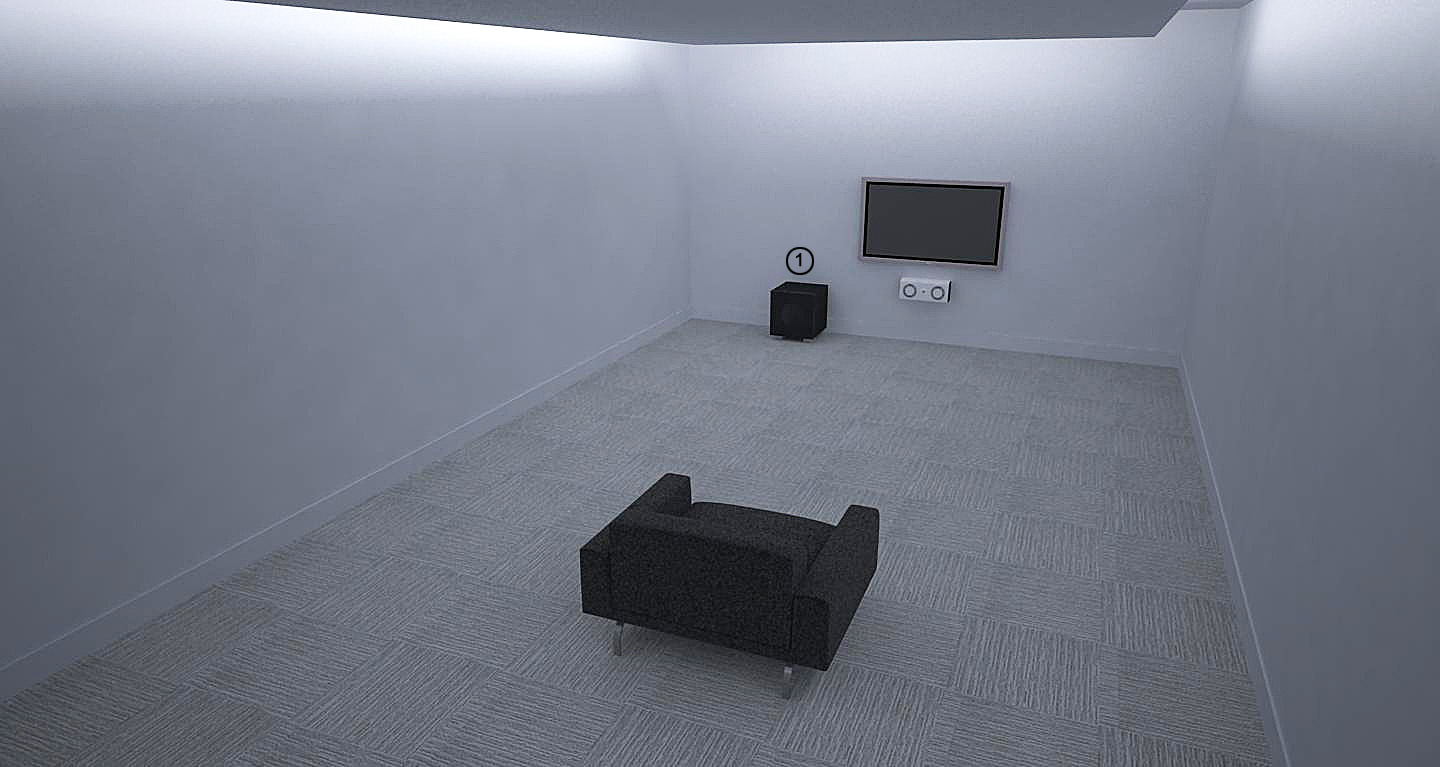REL Room Setup
First select your preferred setup, Theatre or 2-Channel. Then select the type of system to view your setup options. Detailed notes on each position identified are located below the diagram.
2.1 System Room Setup
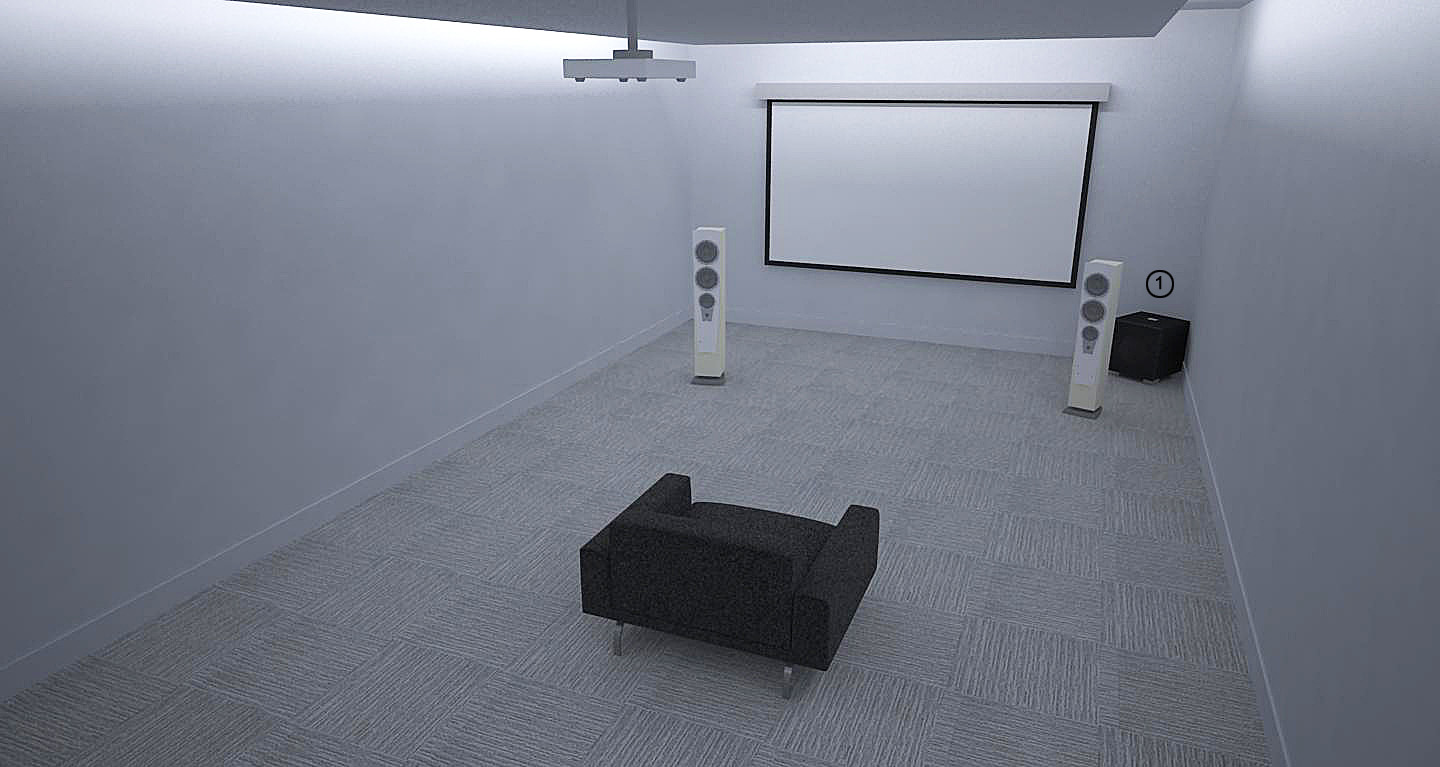
Overview
A 2.1 theater system is capable of amazing performance. Proper placement of a REL subwoofer can maximize these elegantly simply systems by adding depth and dimension to a traditionally flat, directional sounds experience.
Unit Placement
Fig 1:
Ideal positioning is located in one of two front corners nearest the location of the TV and main speakers. Corner positioning reinforces deep bass and produces more efficiency, output for a given volume setting.
If no front corner location is available due to room layout or windows, place in any front location in close proximity to screen and main stereo speakers. This location will result in less deep bass than the primary option, but keeps the stereo speakers and subwoofer integrated and closely tied together. Expect less bass output and less deep bass compared to corner placement, but overall sound will still be well integrated.
* These are recommended best practices for positioning a REL Subwoofer, always refine placement and angle by ear.
** To obtain optimal performance from a REL subwoofer and extend the performance of your speakers, your main speakers must be setup properly. Always follow the setup instructions from your speaker manufacturer first, before setting up your REL.
Dolby 5.1 System - Standard Room Setup
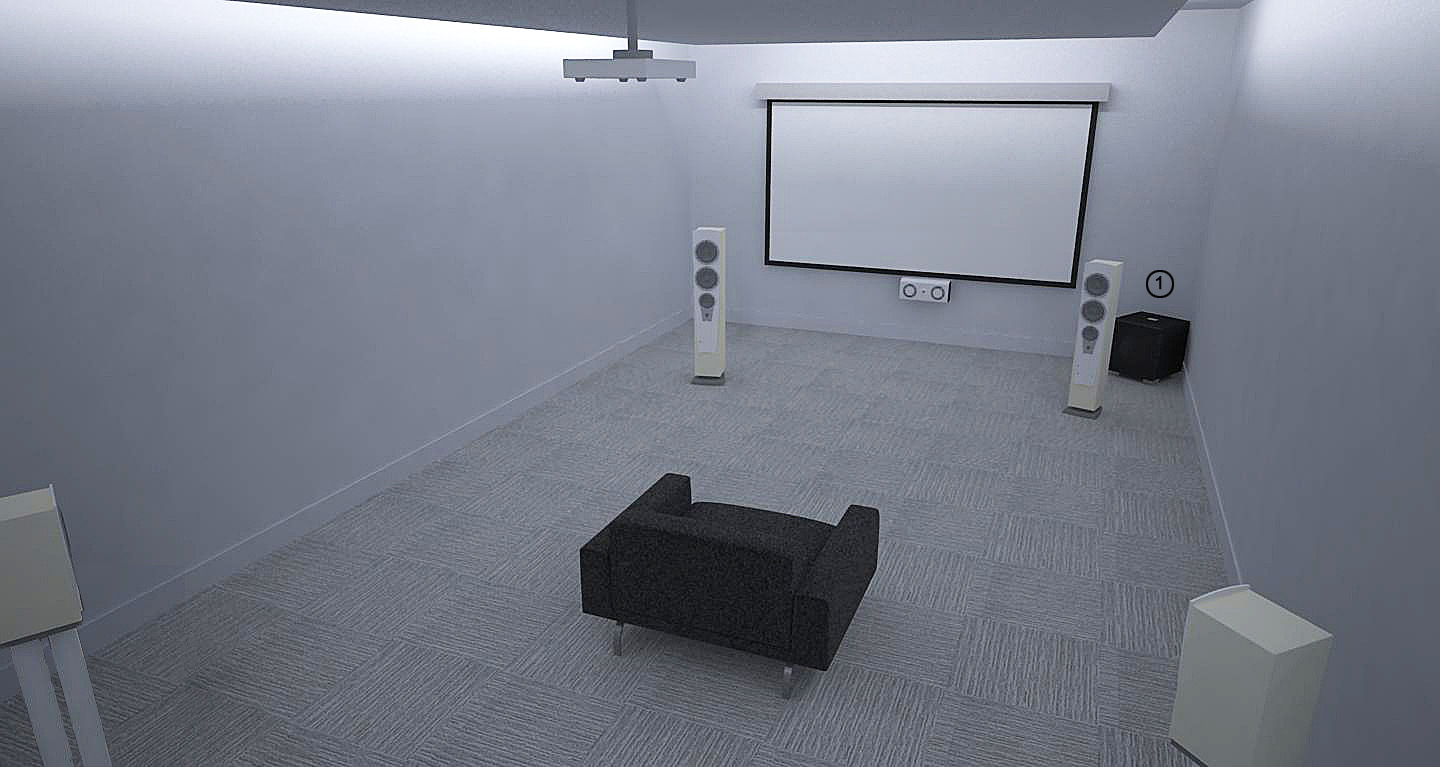
Overview
5.1 Dolby or DTS unlocks discrete individually controllable channels—controllable for level and delays, which permits rich ambient space to be developed. When connecting a REL to these systems consult the technical sections of this website for more detail but please explore Theatre Reference wherein sub bass support under the main speakers is effected by high level connection and speakers set to Large. Then connect the .1 in addition to permit a single REL to deliver BOTH deep rich bass often missing from movie sound tracks as well as deliver spectacular .1 special effects.
Unit Placement
Fig 1:
Ideal positioning is located in one of two front corners nearest the location of the screen and main speakers. Corner positioning reinforces deep bass and produces more efficiency, output for a given volume setting. Take care to turn the sub inward at approximately a 45-degree angle to obtain best release of low notes.
* These are recommended best practices for positioning a REL Subwoofer, always refine placement and angle by ear.
** To obtain optimal performance from a REL subwoofer and extend the performance of your speakers, your main speakers must be setup properly. Always follow the setup instructions from your speaker manufacturer first, before setting up your REL.
Dolby 5.1 System - 3D REL Room Setup
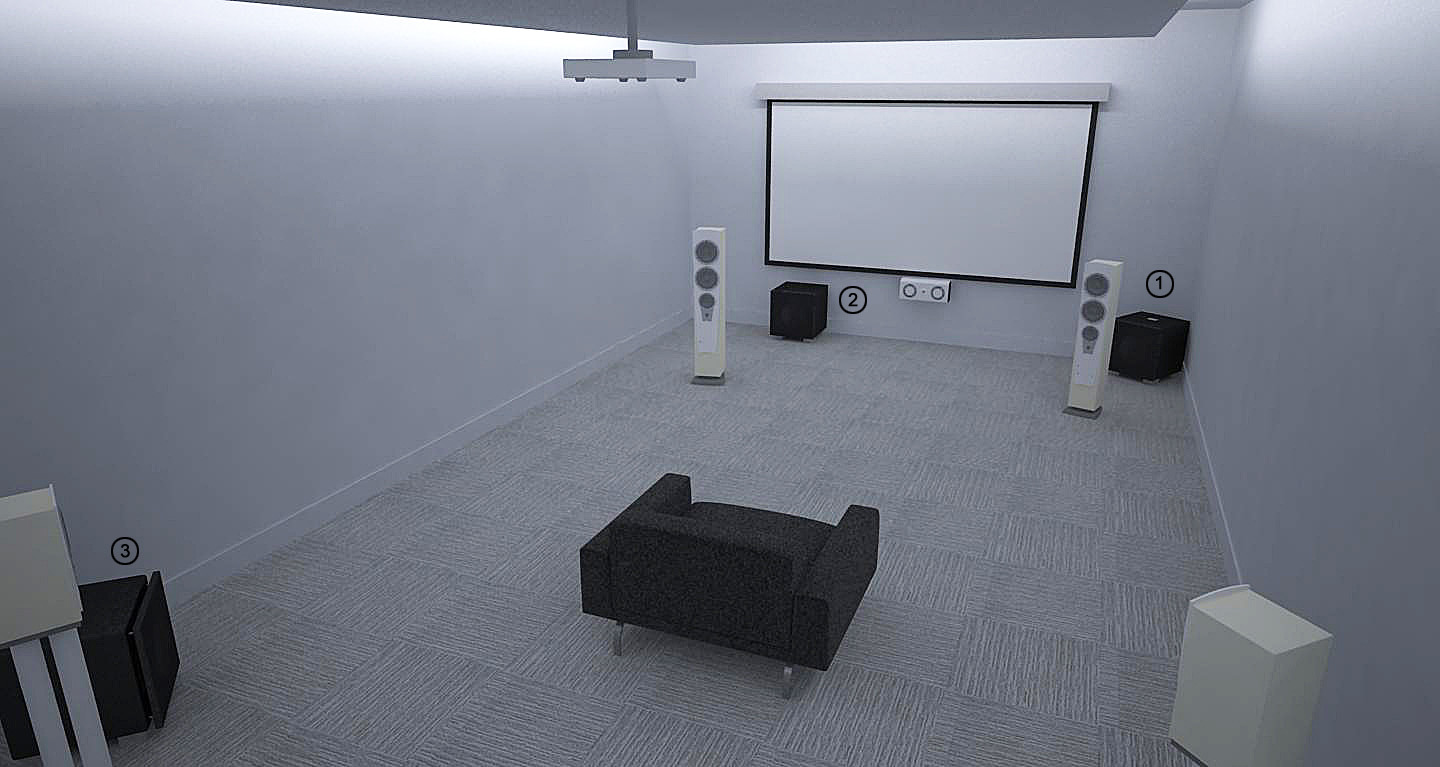
Overview
With Dolby 5.1+ REL 3D we are finally able to deliver the performance promised by 5.1 professional standard by underpinning all three groups of speakers (L/R main, C and Surrounds) with deep, dimensional bass. Doing so places the viewer in the middle of the action since scale, dynamics and excitement are all produced by deep bass. Allowing it to arrive from each channel creates a three dimensional stage in which you are entirely immersed.
Whenever possible, we suggest setting your AV processor or receiver to Large or Full Range in that unit's menu.
Unit Placement
Fig 1:
Determine which front corner location works best for the primary sub. This single sub can supply all the high level bass that turns limited bandwidth speakers into true full range devices (requires conventional Class A/B non- balanced differential amps, 2 RELs are required for balanced differential amplifiers and all mono blocks). Connecting a .1 channel cable to the input marked .1/LFE produces the special effects encoded on this channel. Utilizing both produces the deepest tones from spatially accurate locations, not simply boomy mid-bass like conventional subs produce. This unit will invariably be the largest and most important REL in the system.
Fig 2 - Center Channel:
In order for the center channel to match the scale, deep bass and visceral dynamics of the main speakers, a single smaller REL connected ONLY using the supplied High Level Cable allows the center channel to produce deep bass similar to the main speakers and subwoofer. Simplest connection is directly to the connectors on back of the center channel speaker. This sub is generally the smallest REL sub in the system.
Fig 3 - Surround Channels:
Usually requires just one REL for both channels, connected just like the main sub using High Level to both surround channels and an RCA-RCA .1 channel cable plugged into our .1/LFE connection. This sub should ideally be located in the opposite corner diagonally from the Main L-R sub – for example, the Left rear corner when your main sub is located in the Right front corner.
* These are recommended best practices for positioning a REL Subwoofer, always refine placement and angle by ear.
** To obtain optimal performance from a REL subwoofer and extend the performance of your speakers, your main speakers must be setup properly. Always follow the setup instructions from your speaker manufacturer first, before setting up your REL.
7.2 Standard Room Setup
Dolby 7.1.2+ System - 3D REL Room Setup
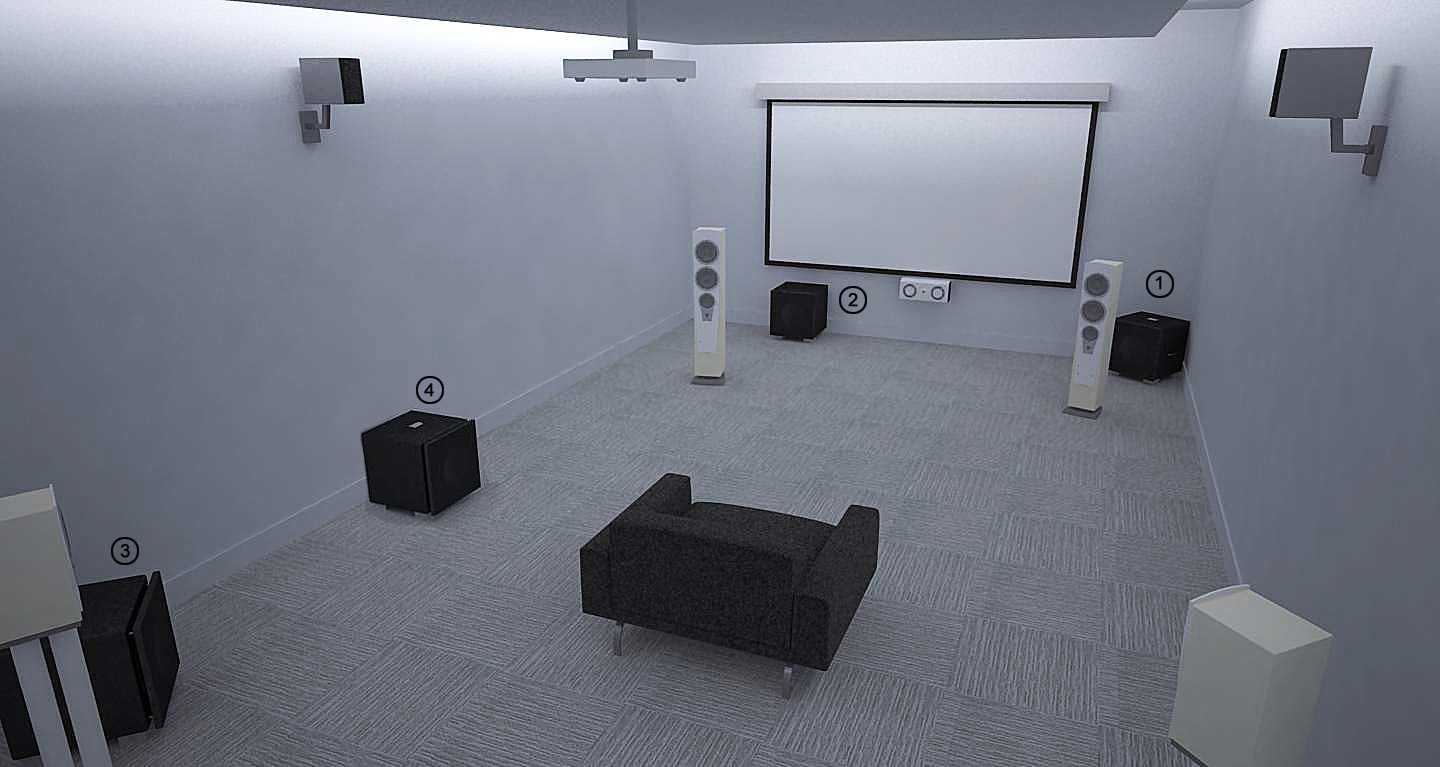
Overview
With Dolby/THX 7.1.2 and larger Atmos systems, we strongly advocate for the use of the REL 3D set-up, as this allows you to harness the atmospheric bass and huge soundstages made available through these extended formats.
As we progress further into the world of individually controllable digital channels configurable for gain and delay with Dolby 7.1.2, we find that REL 3D delivers the performance promised by underpinning all 4 groups of speakers (L/R main, Center and Mid and Rear Surrounds) with deep, dimensional bass. Allowing it to arrive from each channel creates a three dimensional aural stage in which you, the REL 3D owner, are entirely immersed.
Whenever possible, we suggest setting your AV processor or receiver to Large or Full Range in that unit's menu. This permits the High Level Signal connection to receive bass information. Without this, the High Level will NOT function.
Unit Placement
Fig 1:
Determine which front corner location works best for the primary sub. This single sub can supply all the high level bass that turns limited bandwidth speakers into true full range devices (requires conventional Class A/B non- balanced differential amps, 2 RELs are required for balanced differential amplifiers and all mono blocks). Connecting a .1 channel cable to the input marked .1/LFE produces the special effects encoded on this channel. Utilizing both produces the deepest tones from spatially accurate locations, not simply boomy mid-bass like conventional subs produce. This unit will invariably be the largest and most important REL in the system.
Fig 2 - Center Channel:
In order for the center channel to match the scale, deep bass and visceral dynamics of the main speakers, a single smaller REL connected ONLY using the supplied High Level Cable allows the center channel to produce deep bass similar to the main speakers and subwoofer. Simplest connection is directly to the connectors on back of the center channel speaker. This sub is generally the smallest REL sub in the system.
Fig 3 - Surround Channels:
Usually requires just one REL for both channels, connected just like the main sub using High Level to both surround channels and an RCA-RCA .1 channel cable plugged into our .1/LFE connection. This sub should ideally be located in the opposite corner diagonally from the Main L-R sub – for example, the Left rear corner when your main sub is located in the Right front corner.
Fig 4 - 3D+1:
In addition to the ReL 3D protocol, when using Dolby Atmos, it is recommended that 1 additional smaller REL be used for Dolby 7.2’s additional pair of surround speakers. This will serve to provide the low frequency under pinning for that pair of surround speakers. It is NOT necessary to connect the .1 connection if the surround speakers are set to Large and connection is made via High Level. Placement should be along a side wall in line with the extra surrounds if possible, however secondary placement allows for use of the previously unused rear corner of the theater.
* These are recommended best practices for positioning a REL Subwoofer, always refine placement and angle by ear.
** To obtain optimal performance from a REL subwoofer and extend the performance of your speakers, your main speakers must be setup properly. Always follow the setup instructions from your speaker manufacturer first, before setting up your REL.
9.2 Standard Room Setup
Dolby 9.1.2+ System - 3D REL Room Setup
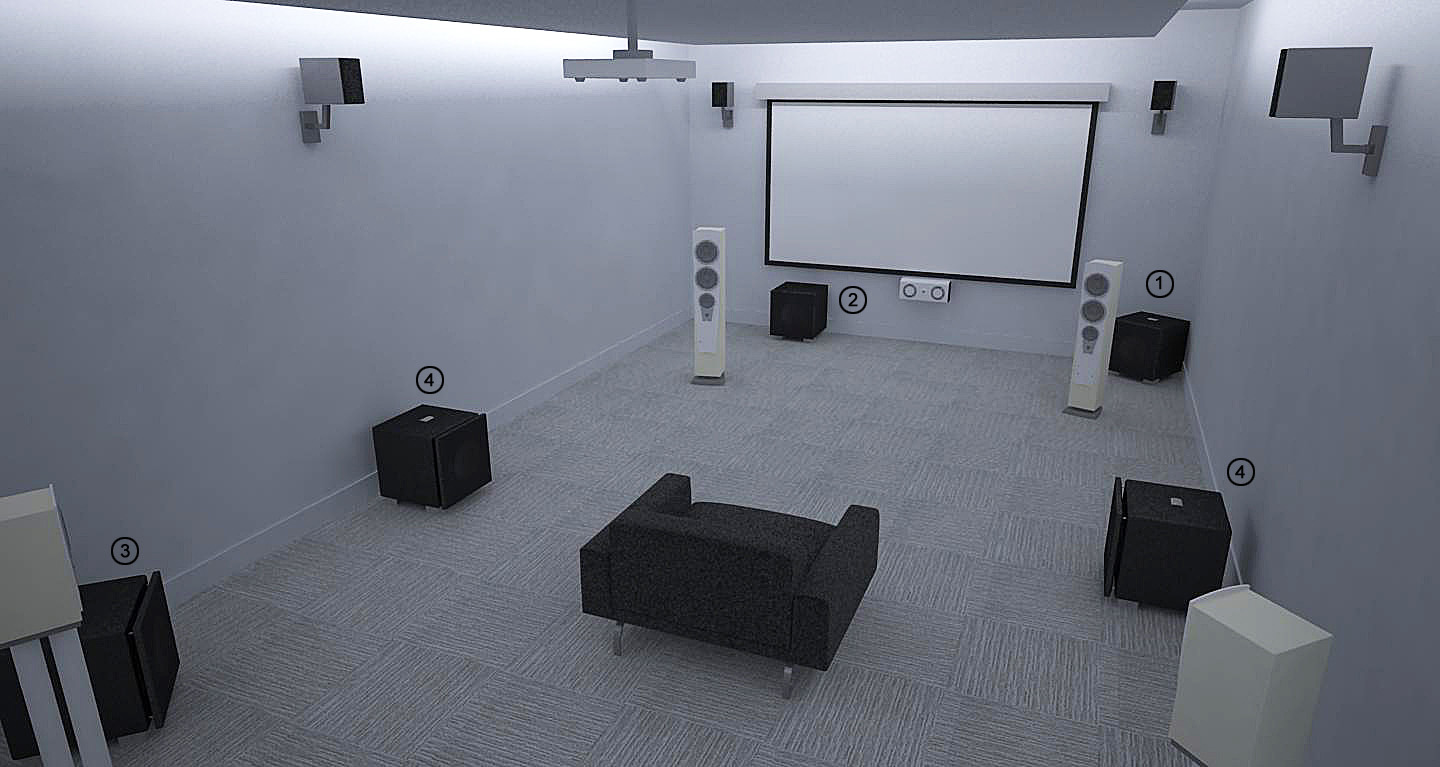
Overview
With Dolby 9.1.2 Atmos, 9.1.4 Atos and larger systems, we strongly advocate for the use of the REL 3D set-up, as this allows you to harness the atmospheric bass and huge soundstages made available through these extended formats.
As we progress further into the world of individually controllable digital channels configurable for gain and delay with Dolby 9.1.2, we find that REL 3D delivers the performance promised by underpinning all 4 groups of speakers (L/R main, Center and Mid and Rear Surrounds) with deep, dimensional bass. Allowing it to arrive from each channel creates a three dimensional aural stage in which you, the REL 3D owner, are entirely immersed.
Whenever possible, we suggest setting your AV processor or receiver to Large or Full Range in that unit's menu. This permits the High Level Signal connection to receive bass information. Without this, the High Level will NOT function.
Unit Placement
Fig 1:
Determine which front corner location works best for the primary sub. This single sub can supply all the high level bass that turns limited bandwidth speakers into true full range devices (requires conventional Class A/B non- balanced differential amps, 2 RELs are required for balanced differential amplifiers and all mono blocks). Connecting a .1 channel cable to the input marked .1/LFE produces the special effects encoded on this channel. Utilizing both produces the deepest tones from spatially accurate locations, not simply boomy mid-bass like conventional subs produce. This unit will invariably be the largest and most important REL in the system.
Fig 2 - Center Channel:
In order for the center channel to match the scale, deep bass and visceral dynamics of the main speakers, a single smaller REL connected ONLY using the supplied High Level Cable allows the center channel to produce deep bass similar to the main speakers and subwoofer. Simplest connection is directly to the connectors on back of the center channel speaker. This sub is generally the smallest REL sub in the system.
Fig 3 - Surround Channels:
Usually requires just one REL for both channels, connected just like the main sub using High Level to both surround channels and an RCA-RCA .1 channel cable plugged into our .1/LFE connection. This sub should ideally be located in the opposite corner diagonally from the Main L-R sub – for example, the Left rear corner when your main sub is located in the Right front corner.
Fig 4 - 3D+2:
In addition to the REL 3D protocol, when using 9.2 Dolby Atmos, it is recommended that 2 additional smaller RELs be used for each additional pair of surround speakers. This will serve to provide the low frequency under pinning for that pair of surround/height speakers.
* These are recommended best practices for positioning a REL Subwoofer, always refine placement and angle by ear.
** To obtain optimal performance from a REL subwoofer and extend the performance of your speakers, your main speakers must be setup properly. Always follow the setup instructions from your speaker manufacturer first, before setting up your REL.
11.2 Standard Room Setup
Dolby 11.1.2+ System - 3D REL Room Setup
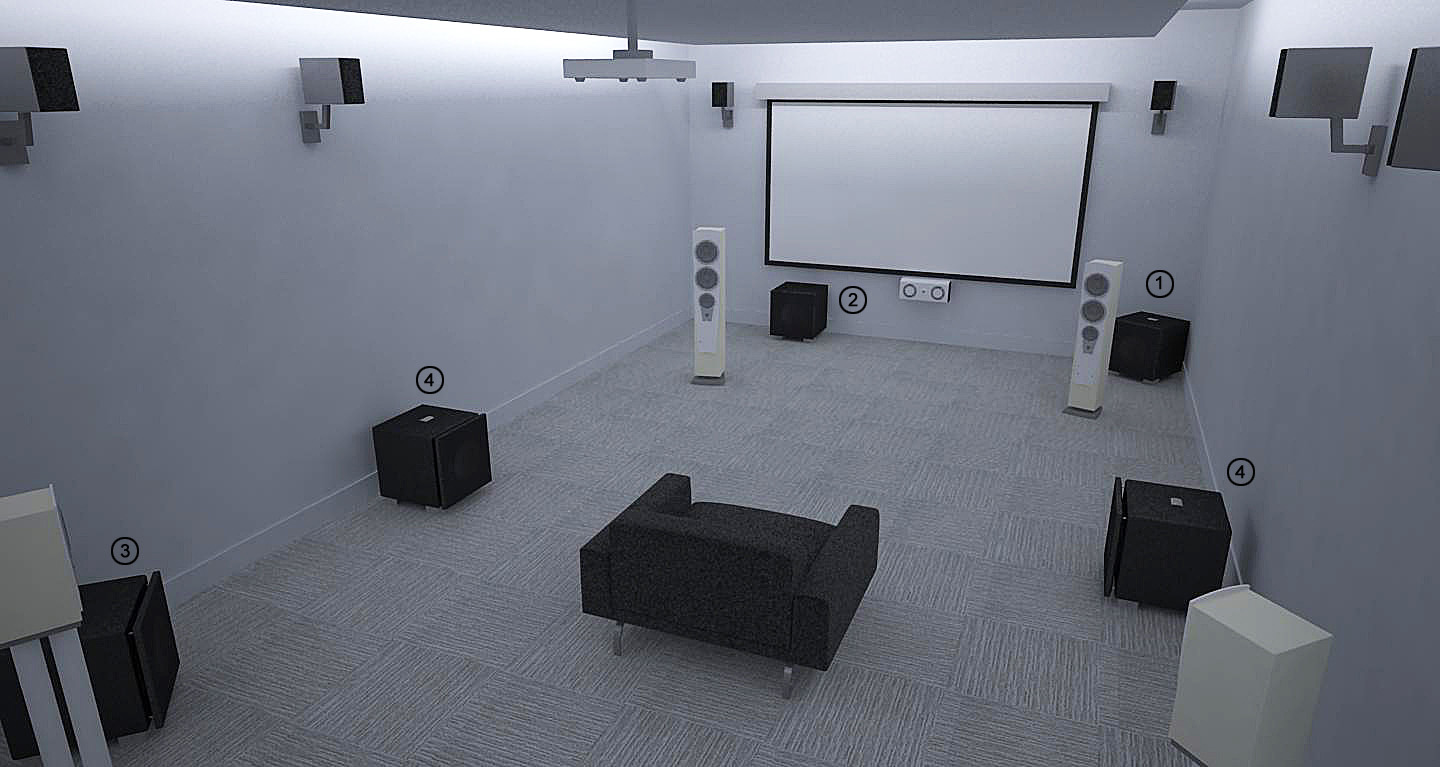
Overview
With Dolby/THX 11.1.2 Atmos, 11.1.4 Atos and larger systems, we strongly advocate for the use of the REL 3D set-up, as this allows you to harness the atmospheric bass and huge soundstages made available through these extended formats.
As we progress further into the world of individually controllable digital channels configurable for gain and delay with Dolby 11.1.2, we find that REL 3D delivers the performance promised by underpinning all 4 groups of speakers (L/R main, Center and Mid and Rear Surrounds) with deep, dimensional bass. Allowing it to arrive from each channel creates a three dimensional aural stage in which you, the REL 3D owner, are entirely immersed.
Whenever possible, we suggest setting your AV processor or receiver to Large or Full Range in that unit's menu. This permits the High Level Signal connection to receive bass information. Without this, the High Level will NOT function.
Unit Placement
Fig 1:
Determine which front corner location works best for the primary sub. This single sub can supply all the high level bass that turns limited bandwidth speakers into true full range devices (requires conventional Class A/B non- balanced differential amps, 2 RELs are required for balanced differential amplifiers and all mono blocks). Connecting a .1 channel cable to the input marked .1/LFE produces the special effects encoded on this channel. Utilizing both produces the deepest tones from spatially accurate locations, not simply boomy mid-bass like conventional subs produce. This unit will invariably be the largest and most important REL in the system.
Fig 2 - Center Channel:
In order for the center channel to match the scale, deep bass and visceral dynamics of the main speakers, a single smaller REL connected ONLY using the supplied High Level Cable allows the center channel to produce deep bass similar to the main speakers and subwoofer. Simplest connection is directly to the connectors on back of the center channel speaker. This sub is generally the smallest REL sub in the system.
Fig 3 - Surround Channels:
Usually requires just one REL for both channels, connected just like the main sub using High Level to both surround channels and an RCA-RCA .1 channel cable plugged into our .1/LFE connection. This sub should ideally be located in the opposite corner diagonally from the Main L-R sub – for example, the Left rear corner when your main sub is located in the Right front corner.
Fig 4 - 3D+2:
In addition to the REL 3D protocol, when using 11.2 Dolby Atmos, it is recommended that 2 additional smaller RELs be used for each additional pair of surround speaker, 1 for the extra surrounds and another for the heightsurrounds. A third additional REL may be used to support the width enhancing speakers but this is overkill in most instances. This will serve to provide the low frequency under pinning for each pair of surround/height speakers.
* These are recommended best practices for positioning a REL Subwoofer, always refine placement and angle by ear.
** To obtain optimal performance from a REL subwoofer and extend the performance of your speakers, your main speakers must be setup properly. Always follow the setup instructions from your speaker manufacturer first, before setting up your REL.
2-Channel Single Room Setup
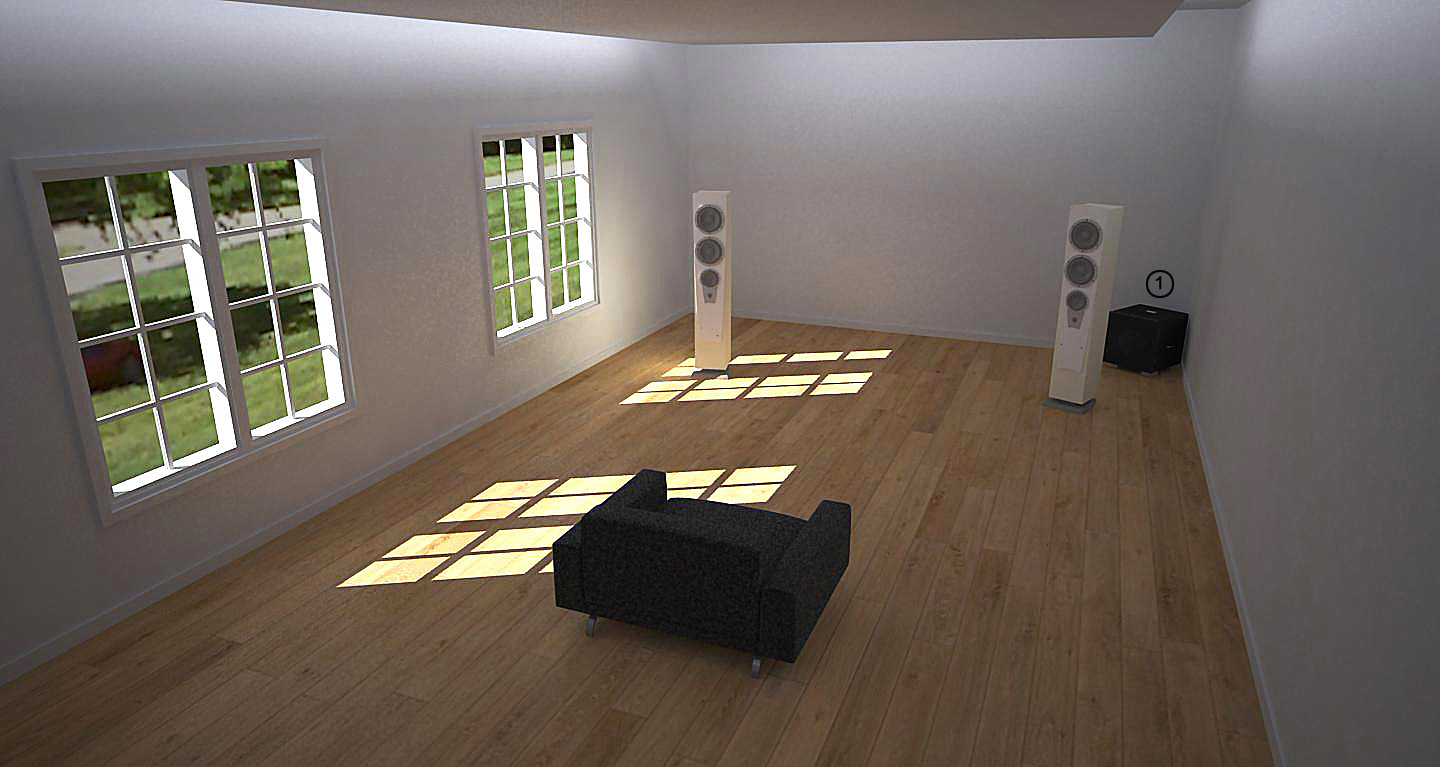
Overview
RELs uniquely offer benefits that extend well beyond the bass regions of 2-channel systems. By working with the speakers, instead of being layered on top, RELs restore the lowest bass to form a stable foundation for the speakers to build up from; allowing music to soar and the soundstage to expand in all directions. We call this the REL Effect.
Unit Placement
Fig 1:
Because REL are engineered to produce foundational low bass, it is beneficial to place a single REL into a structural corner at the front of the room, immediately behind the main front speakers. If you have a choice of corners, select the corner that is either built from stronger material (Masonry vs. Sheetrock). If both corners are made from sheetrock, select the sturdier of the two corners avoiding any breaks in the walls such as doors or windows in close proximity to the corner. Turn inward toward the center of the room pointing directly or almost directly at the prime listening location.
* These are recommended best practices for positioning a REL Subwoofer, always refine placement and angle by ear.
** To obtain optimal performance from a REL subwoofer and extend the performance of your speakers, your main speakers must be setup properly. Always follow the setup instructions from your speaker manufacturer first, before setting up your REL.
2-Channel Stereo Pair Room Setup
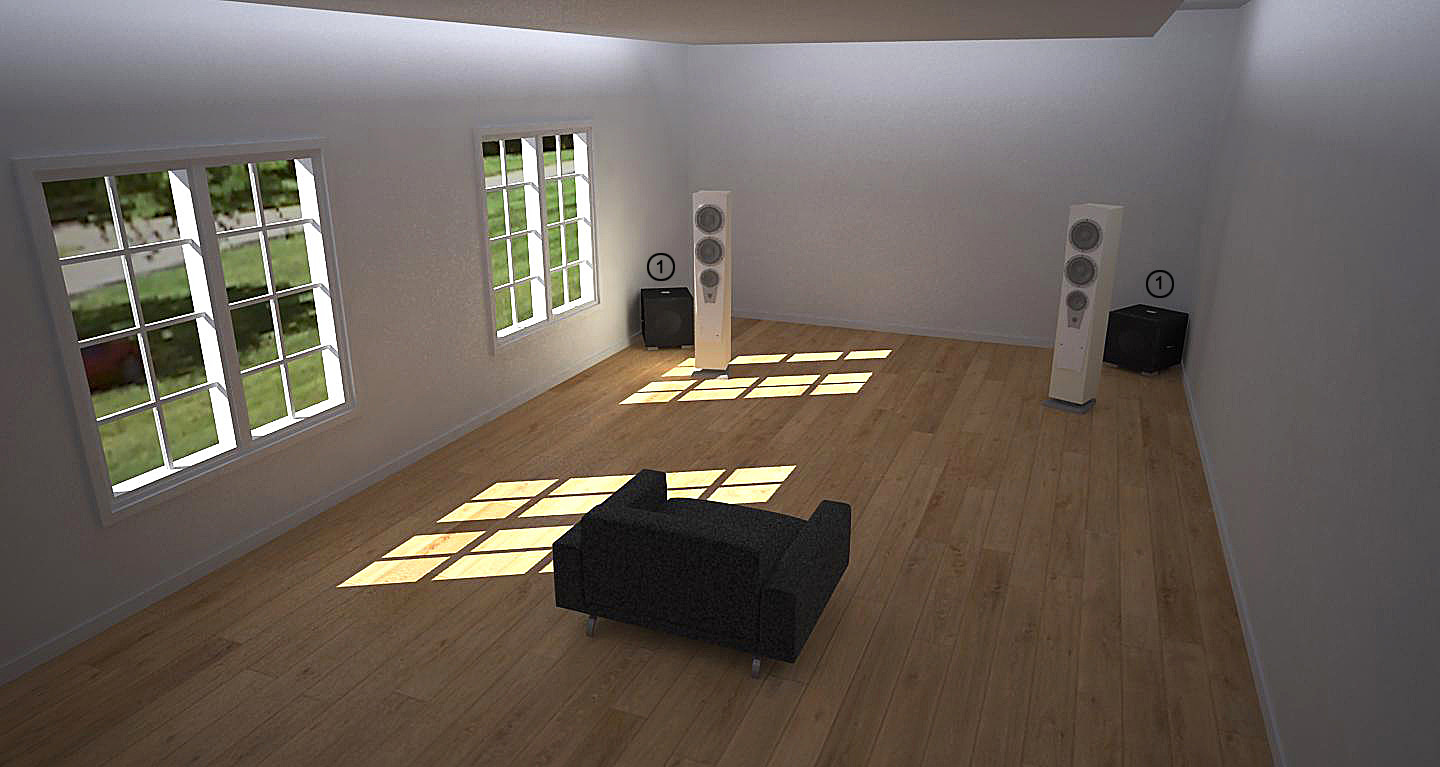
Overview
Using stereo pairs (two REL subwoofers) to support high quality speakers extends far beyond simply increasing the quantity of low bass in a system. A Stereo pair of RELs greatly increases the focus, clarity and range of the entire sound system by enhancing details in the upper-midrange and low treble of the speakers. This greatly illuminates the musicians or action in a movie soundtrack, increasing intelligibility and intimacy of the moment.
Unit Placement
Fig 1A:
Because RELs are engineered to produce foundational low bass, it is beneficial to place pairs into front structural corners, immediately behind the main front speakers. Turned inward toward the center of the room to a position that points directly or almost directly at the prime listening location.
Fig 1B:
FFor stereo pairs, this basic approach of corner placement may work well. However, for larger RELs, especially in small or medium rooms, it may work best to place the subwoofers in close proximity to the main speakers, just behind and to the outside of main speakers. Doing so ensures that these larger RELs and the main speakers act like a single unified whole, and with 2 large RELs there is almost certain to be sufficient output, making corner placement unnecessary.
* These are recommended best practices for positioning a REL Subwoofer, always refine placement and angle by ear.
** To obtain optimal performance from a REL subwoofer and extend the performance of your speakers, your main speakers must be setup properly. Always follow the setup instructions from your speaker manufacturer first, before setting up your REL.
2-Channel Vertical Stereo Stacks Room Setup
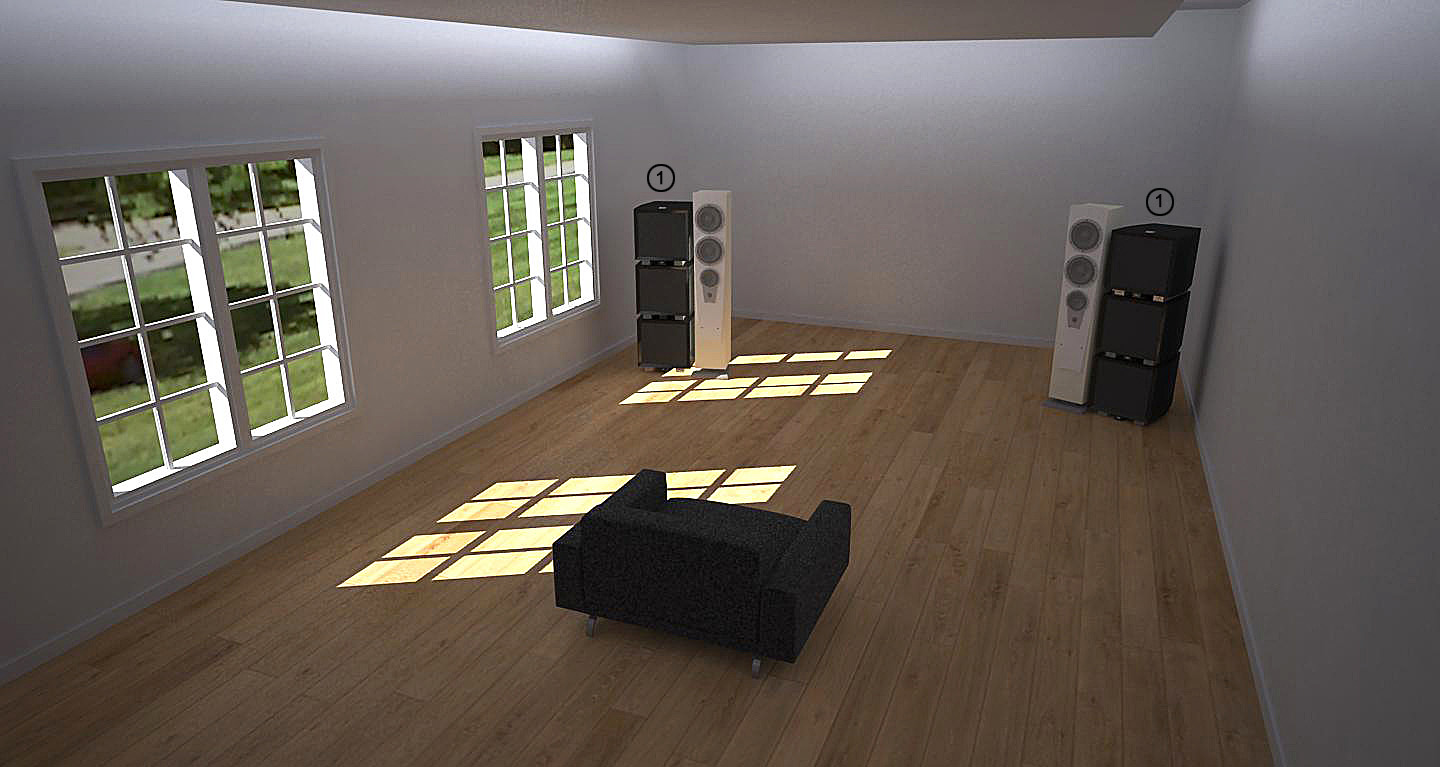
Overview
The vertical stack is the Holy Grail of REL ownership. Typically, it is used for all out attacks on the state of the art for both music and film, and thus, is limited to reference-level RELs. The Vertical Stack delivers veritable oceans of bass from floor to ceiling, and unparalleled realism as the bass surrounds listeners – an experience known only to those actually present in the recording venue.
Unit Placement
Fig 1:
When placing vertical stacks, they will be in close proximity to the main speakers, not generally placed in corners, but immediately outside of and slightly behind the main speakers. They should be turned inward toward the center of the room to a position that points directly or almost directly at the prime listening location. A REL specialist trained in vertical stack set-up should be retained for tuning, which is why reference-level product is never sold over the Internet.
* These are recommended best practices for positioning a REL Subwoofer, always refine placement and angle by ear.
** To obtain optimal performance from a REL subwoofer and extend the performance of your speakers, your main speakers must be setup properly. Always follow the setup instructions from your speaker manufacturer first, before setting up your REL.











